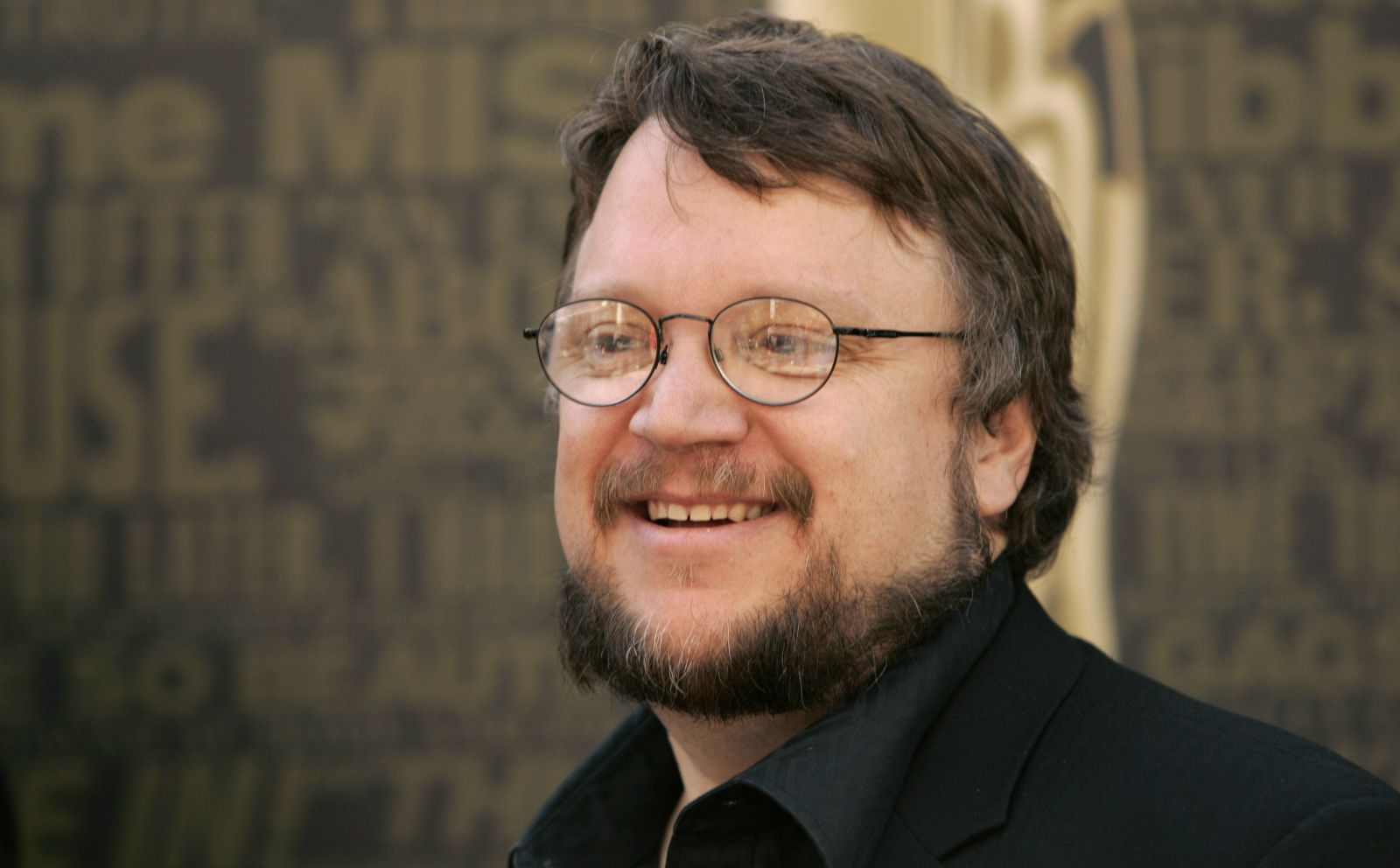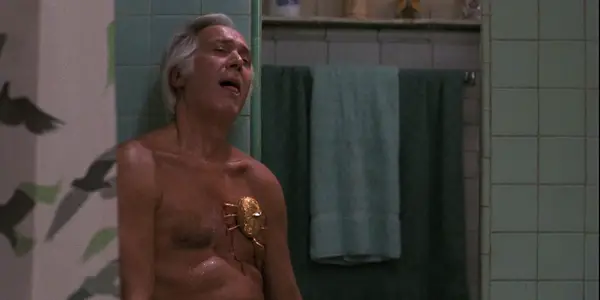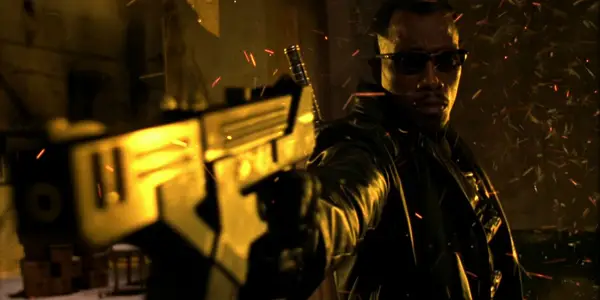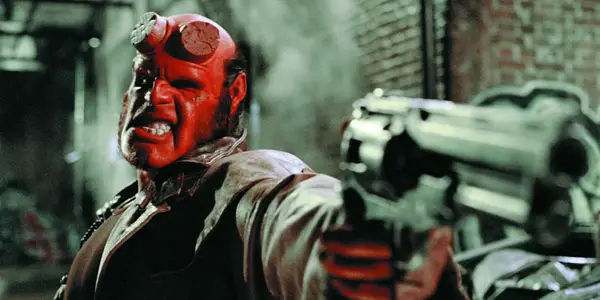The Beginner’s Guide: Guillermo del Toro, Director

Ben's milkshake is unisex and brings everyone to the yard.…
Near the conclusion of Hellboy II, we find the eponymous hero at death’s doorstep. Hellboy is laid at the feet of his personal Angel of Death, a shrouded, veiled monstrosity whose ragged wings are festooned with a series of enormous, amber eyes. Elizabeth Sherman, Hellboy’s partner, cradles his unconscious body in a pose reminiscent of the Pietà, an aesthetic emphasized by the magical spearpoint thrust into Hellboy’s side. Even as Liz pleas for Hellboy’s life, she is confronted by an ominous truth: as Anung-un-Rama, a demon messiah, Hellboy is destined to destroy the world of men. By saving Hellboy’s life, Liz may be sentencing millions to death. The Angel grants her request, but offers a word of warning. “The time will come,” the apparition hisses, “and you, my dear, will suffer more than anyone.”
Caught up in this moment of pure visual mastery and mythic portent, it’s easy to forget that Hellboy is a mere comic book adaptation. In lesser hands, the sequence might collapse under the sheer weight of disparity; religious symbolism, resplendent production design, and fantastical subject matter. The extent to which these elements are balanced speaks to the singular nature of the film’s director. Guillermo Del Toro is an auteur of seemingly impossible dichotomies: of light and dark; of pulp premises and transcendent messages; of aching melancholy and fortifying warmth.
To approach Del Toro’s body of work is to step into the dark; to view the world from behind Fuseli’s nightmare curtain. Del Toro’s world is beset by monsters, but his monsters are more than objects of fear. The apparitions that haunt his work are cracked reflections of humanity, at once totemic and sympathetic; symbols of ancient power and ineffable loneliness.
Del Toro’s reverence for the monster extends beyond the thematic – he understands that much of a monster’s power lies in its physicality, and goes to great lengths to ensure that his creatures, and the environments they inhabit, are rendered in loving and meticulous detail. Though his subjects are often gruesome and imperfect, Del Toro eschews the bleakness that so often accompanies his chosen genres. Beneath the layers of breathtaking and often horrific artifice which adorn his productions, Del Toro’s films offer luminous messages of hope and wonder.
The following list provides a narrative introduction to each of Del Toro‘s films, as well as a brief analysis of persistent themes and notable elements. Please note that this list only details Del Toro’s directorial work – for a full list of his credits, please visit his IMDB profile.
Cronos (1993)

It is rare for a director’s debut feature to offer a representative view of the filmmaker’s definitive flavor. In Cronos, a 28-year-old Guillermo Del Toro puts his cards on the table with astounding skill and confidence. Many of the themes and techniques which will enrich his later work are not only present, but developed well beyond the nascence one might expect given Del Toro’s relative lack of experience.
Shot in Del Toro’s native Mexico, Cronos tells the story of Jesus Gris, an elderly antiques dealer who discovers a strange, scarab-like device hidden within a 16th century statue. Jesus soon discovers that the device, the masterwork of a gifted alchemist, holds the key to immortality. Cronos bestows its gift, but at a terrible cost: Jesus has begun to change in horrific, fundamental ways.
As Jesus struggles to maintain his humanity, a dying millionaire in possession of the alchemist’s tome traces Cronos to Jesus’ shop and sends his sadistic nephew to retrieve the device. In a failed attempt to strong arm Jesus, the thug kills the antique dealer. Jesus awakens in the morgue, faced with the horrible realization that Cronos won’t let him die. Jesus has become a monster, blessed with immortality but cursed with a thirst for human blood.
The tug-of-war between Jesus’ monstrosity and humanity is heartbreaking. Despite the decay of his body and his need for blood, he is committed to his essential goodness. Some of the film’s most poignant scenes feature the interactions between Jesus and his granddaughter Aurora. Her childlike love for her grandfather outweighs her revulsion at his pale, rotting flesh, and she acts as Jesus’ anchor in the world of the living. The importance of family is a theme that will resurface frequently within Del Toro’s oeuvre.
Cronos is Del Toro’s first feature and one of his best. It offers a surprisingly tender and endlessly innovative spin on the vampire tale, and sets the thematic tone for much of the director’s subsequent work. Cronos is also notable as Del Toro’s first collaboration with one of his later stalwarts, Ron Perlman.
Mimic (1997)

Del Toro’s first foray into Hollywood is a disappointing one. It’s the director’s least favorite of his films, and despite some interesting elements, it’s easy to see why. Despite its shortcomings, Mimic features a strong central premise. In an effort to quell the spread of a fatal epidemic, a pair of entomologists create the ‘Judas Breed,’ a hybrid insect which kills off disease-carrying c*ckroaches by secreting a specialized enzyme. The population of Judases is programmed to expire after 180 days, minimizing the solution’s impact to the ecosystem. Three years later, with the disease eradicated and the scientists lauded as heroes, a Judas specimen resurfaces. The scientists’ struggle to unravel the Judas Breed’s seemingly impossible survival coincides with a series of bizarre deaths and the sightings of a mysterious, shrouded figure in and around New York’s subway system.
The first third of the picture is excellent, unfolding the early narrative with a trudging, brooding dread. As the film progresses, the executive pressure which Del Toro blames for Mimic’s commercial and dramatic failures becomes increasingly apparent. Mimic answers cerebral questions with silly, staid answers, resorting to hectic action and an overabundance of CGI which appears to have rotted rather than aged.
Shortcoming aside, the film showcases some of Del Toro’s technical flair. His shots are carefully constructed and rich with texture, and the creature designs are suitably grotesque and inventive. For Del Toro fans, Mimic’s Director’s Cut is worth seeking out – it fails to surmount all of Mimic’s flaws, but it does narrow the gap between the production release and the director’s original vision.
The Devil’s Backbone (2001)

Del Toro’s next film is The Devil’s Backbone, a dense and politically charged ghost story set during the Spanish Civil War, features one of the most haunting opening sequences in modern cinema:
Fade in. The camera moves toward a darkened doorway. “What is a ghost?” a voice asks. “A tragedy condemned to repeat itself time and again?” We enter the blackness of the doorway, and suddenly the blackness is disrupted as a set of doors open, and we watch from above as a bomb falls to a rainy landscape pitted with explosive craters. The doors close, and we are returned to blackness.
The Devil’s Backbone is Del Toro’s most complex film, both in terms of its narrative construction and its allegorical layers. The challenge of the film is heightened by a specific set of historical and cultural touchpoints – there are parts of the film, including an upsetting sequence that lends the film its title, that seem almost inaccessible to those unfamiliar with Spain’s troubled history.
The film is a ghost story, but it’s also a dense and unflinching meditation on war and violence. Again, Del Toro’s gift for balancing disparate cinematic elements comes to the fore, but at times, the narrative complexity weighs the film down. The Devil’s Backbone is the most overtly frightening of Del Toro’s films, and it’s also the most challenging.
Blade II (2002)

Though far from his best work, Del Toro’s second attempt at the Hollywood blockbuster is markedly more successful than the first. The second film of a competent trilogy, Blade II finds the titular half-human/half-vampire assassin on the trail of Whistler, his erstwhile mentor and recently ‘turned’ vampire.
In his opening narration, Blade goes to great lengths to establish the Whistler situation as a key plot point. It’s odd then, that Whistler has been rescued AND turned back into a human by the time Blade II hits the 20-minute mark. It’s the first in an odd series of missteps scattered throughout the film. Blade II makes few attempts at coherence, but goes all out when it comes to style.
Del Toro lets David Goyer’s script stand on its own, focusing his energies on the look of the film. He carries the schlock with aplomb, reveling in Blade’s dual-wielding, katana-slashing theatrics. There are some typically wonderful Del Toro designs, most notably a subset of hybrid vampires whose jaws open like batwing-doors, an aesthetic he’ll later riff on for his FX vampire series, The Strain.
Blade II is the most successful of the series, but aside from a slew of interesting gadgets and creatures (and Ron Perlman sporting this haircut), it’s forgettable.
Hellboy (2004)

Although Hellboy is adapted from the work of comic maestro Mike Mignola, the eponymous hero is a Del Toro character through and through. Hellboy arrives on earth after a secret Nazi division, with the help of Grigori Rasputin (because why not), attempts to summon a Lovecraftian doom god to help the Third-Reich defeat the allies. Yes, you read that correctly. Take a moment.
Ahem. Hellboy, a seemingly unrelated piece of trans-dimensional baggage, is adopted by paranormal expert Trevor Bruttenholm and raised as a human. Hellboy grows at an acclerated rate, and is soon conducting missions for the Bureau of Paranormal Research and Defense, Bruttenholm’s secret agency that combats paranormal threats. “There are things that go bump in the night,” John Hurt’s Bruttenholm explains, “and we are the ones who bump back.”
Hellboy’s central character arc is pure Del Toro: he is both powerful and vulnerable, a tragic monster searching for his better self. Hellboy’s narrative, and much of its humor, revolves around his constant struggle for integration. (He files the horns on his forehead so he’ll ‘fit in.’) Hellboy is driven by the approval of his adopted father, but curious about his demonic nature. The conflict intensifies when Hellboy begins to learn about the purpose of his enormous, stone hand.
Though Del Toro’s changes to the narrative rob the film of Mignola’s brooding sensibilities, Hellboy captures the cosmic struggle and absurd appeal of the title character. Ron Perlman is perfectly cast, and provides a gruff, lovable performance that sets his character apart from the cavalcade of mid 2000’s comic heroes.
Hellboy represents Del Toro’s arrival as a Hollywood fixture. The quality of his work has granted him both creative and financial clout, enabling him to pair the might of mainstream production with the guile of his creative viewpoint. The result is hugely successful – Hellboy is a charming introduction to a classic character and a fascinating new franchise.
Pan’s Labyrinth (2006)

Barring some unforeseen masterpiece, Pan’s Labyrinth will likely be regarded as Del Toro’s magnum opus. The film is nearly perfect in its own right, but it is also the most salient marriage of Del Toro’s most prominent themes and evocative visual language. Pan’s Labyrinth is one of the most beautiful and striking pieces ever set to film, and cements Del Toro’s place as an unequaled stylist. Set shortly after the Spanish Civil War, the film tells the story of Ofelia, a child who travels with her pregnant mother Carmen to the estate of Captain Vidal, a fascist military officer and the father of Carmen’s unborn child.
Seeking refuge, Ofelia follows a fairy – who appears as a mere stick insect to unbelievers – into an underground labyrinth. There, Ofelia meets an ancient faun who tells her that she is the incarnation of Princess Moanna, rightful heir to the a magical kingdom of the underworld. Only by completing three tasks, the faun tells her, will she be able to claim her immortal birthright.
Ofelia’s sojourns into the magical underworld are juxtaposed to the brutal realities of her life above ground. Captain Vidal is a deranged sadist and murderer, and Carmen’s health is waning. The contrast between the fantastical and the horrifically real lends the film a surreal, dreamlike quality, and leads to an interesting range of interpretations. Is Ofelia’s fantasy world merely an escape from the fears of painful childhood, or does something truly magical wait in the dark places of the world?
The spiritual successor to The Devil’s Backbone, Pan’s Labyrinth unearths troubling allegorical questions about fascism and violence, but where the previous work is occasionally overwrought, Labyrinth is cleaner and more lucid. Guillermo Del Toro invites us into a dark, lush fairy-tale world, where magic lingers just outside the margins of reality and men are more monstrous than anything we imagine when the lights go out.
Hellboy II: The Golden Army (2008)

Hellboy II: The Golden Army is an excellent sequel. It maintains the interesting characterizations from the first film and expands the scope of the adventure in satisfying, creative ways. Whereas the first Hellboy feature spends much of its time explaining Hellboy’s existence and setting the stage for his development, the second volume is committed to myth-building.
The film begins with a gorgeous animated sequence in which wooden puppets enact an ancient fable. In an effort to end an age-old struggle between men and elves, the Elven king creates an indestructible army of golden machines. When it becomes clear that the Golden Army is too powerful, the two armies form a truce – humankind will remain in the cities, while magical beings will occupy the forests and natural places of the world.
The story progresses to the modern day, where the deposed and embittered Prince Nuada seeks to gain control of the Golden Army and restore his people to their former glory. Over the years, as mankind has encroached upon the natural world, the dwindling magical races are forced to find refuge in the empty spaces of mankind’s industrial sprawl. Del Toro’s visual marriage of fantastical and urban elements gives Hellboy II’s locations a unique and striking aesthetic. The Elf King’s subterranean throne room, with it’s amber-hued warmth and perpetual fall of autumn leaves, is particularly representative of Del Toro’s style.
A visit to the Troll Market, a hidden magical gathering place hidden beneath the Brooklyn Bridge, is Del Toro’s exuberant rejoinder to George Lucas’ Mos Eisley Cantina. The market is a fever dream of brilliant costuming and masterful fabrication, a stunning highlight reel for Del Toro and his team of designers.
Hellboy II is a satisfying continuation of its title character’s development, and provides ample opportunity for Del Toro to exercise his unequaled visual talent.
Pacific Rim (2013)

Pacific Rim is Del Toro’s love letter to the monster movies of his childhood, and it represents the director at the peak of unabashed delight. It is a spectacle in its truest sense, a film that aims to synthesize adolescent wonder; and it succeeds in zany, punch-drunk style.
In the not-too-distant future, humanity is attacked by a series of gargantuan monsters, called Kaiju, from beneath the surface of the ocean. In response, human kind has created a small force of Jaegers – giant manned robots tasked with hunting the monsters down.
Let’s not mince words – this is a movie about giant robots beating the living hell out of giant monsters. It features characters with names like Hannibal Chu and Stacker Pentecost. The good guys are good, the bad guys are bad, and at one point, a giant war machine named “Gypsy Danger” clobbers a Godzilla-esque behemoth with the blunt edge of a cargo ship.
Del Toro tackles Pacific Rim with a refreshing sense of earnestness, rejecting the winking irony which could so easily have infected this type of production. He approaches the subject matter at face value, imbuing the proceedings with both reverence and a sense of fun. The action scenes, of which there are many, are lovingly animated. Del Toro dismisses the appeal of postmodernism, but whether or not he’ll admit it, his intertextual references are clear and powerful. The rain-drenched battle sequences between Jaeger and Kaiju evoke the scale and spectacle of Goya’s Colossus.
Pacific Rim evinces Del Toro’s warm and egalitarian approach to his craft. He’s an artist who finds as much value in ‘movies’ as he does in ‘films.’ He is good, and smart, but never too good or too smart for the film to which he is currently devoted. He makes art that he loves, and it’s hard not to love him for it.
Conclusion
Guillermo del Toro lurks in the dark crevasses of our cinematic landscape, inviting us behind the freak show canvas and beckoning to us from under the bed. At his lowest ebb, he is a creative technician whose stubborn pursuit of his peculiar affections is enacted at the cost of coherence. His films, especially those created under pressure from major studios, are occasionally slipshod, sacrificing pacing and narrative clarity on the altar of visual eloquence and painstaking production design. For Del Toro, there’s little daylight between style and substance; it’s his greatest strength and greatest weakness.
At his best, Del Toro is a singular artist capable of astounding visual beauty and resonant narratives. When given license to pair his unmatched aesthetic nous to suitably unfettered subject matter, he is peerless. His purest work is at once complex and earnest, eschewing cynicism and embracing wonder; of art, of creation, and of the horror that makes us human.
What are your impressions of Guillermo Del Toro’s work? Which of his films is the most effective? Let us know.
Does content like this matter to you?
Become a Member and support film journalism. Unlock access to all of Film Inquiry`s great articles. Join a community of like-minded readers who are passionate about cinema - get access to our private members Network, give back to independent filmmakers, and more.
Ben's milkshake is unisex and brings everyone to the yard. He'd love to give you more information about it but doesn't work pro bono.













